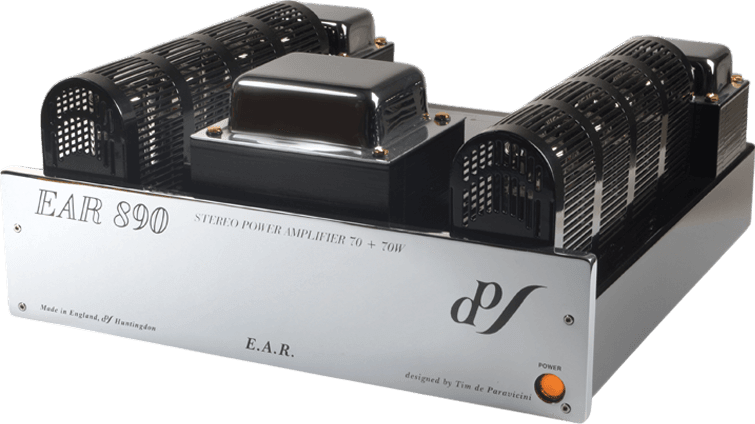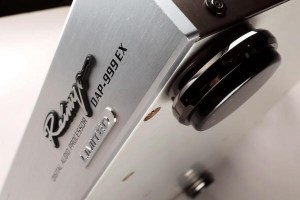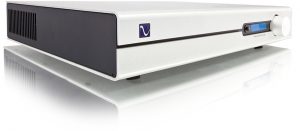This article, as reviewed by Francisco Duran, Dave Clark, Larry Fisher, and Larry Cox, originally ran in audioMusings' Issue 12, 2000 and then in Issue 1, June/July 2002 of Positive Feedback
To say that the 47 Labs CD combo is unconventional in its design and looks is an understatement. The Model 4713 Flatfish player/transport is a rather small, rectangular, top-loading unit that is precariously perched atop three spikes. All of its controls are on the top front, along with its hard-to-read display (that is, hard to read unless you are looking down on it). The Model 4705 Progression DAC is a smaller rectangular box. The cylindrical Model 4799 Power Dumpty power supply reminds me of a piston out of a big block engine.Both the DAC and player can be powered by it. The 4713 features a "hard suspension system." Its platform and casing is a thick, machined aluminum board with the driving and pickup mechanisms and critical circuits directly mounted to it, which helps to reduce vibrations that can affect the sound quality. The same thinking went into the DAC and power supply. Some of the unique features of the DAC are that it is a non-oversampling design, with no digital or analog filters. The conversion is handled by a passive instead of an active device. It boasts the "world's shortest signal path" for a DAC, just 35 mm, along with the world's smallest number of parts—just 20—housed in a two-piece chassis made from a machined aluminum block. The output, which is important to us passive-ists, is 2.1 volts. Neither the player nor the transport/DAC combo had problems driving my system to quite high levels.
To play a CD with the Flatfish, you have to remove a threaded clamp and protective disc from the top, put the CD in place, then screw the threaded clamp back down. Gee, what does that remind you of? Too much trouble, you say? Just hit the play button, then see if you complain! This is one sweet and clean music-making machine, with almost no grain, glare, or trace of any digital artifacts. By now I've become very familiar with Alvin Youngblood Hart's Big Mamma's Door CD. Many songs on this disc are just Hart, his voice, and a steel guitar. With this well-recorded disc, I could hear every nuance of vocal inflection. Harmonic overtones and finger plucks were laid out in front of me. The Flatfish reproduced this music with an organic wholeness and warmth that reminded me of tubes, but without any coloration or euphonics. Plucked guitar strings did not have too much energy or bite. Cymbals were well controlled, yet did not sound rolled off. Vocals were in proportion and natural. Each voice seemed to come out of a body instead of just a mouth.
I noticed plenty of air around the trumpet solo of track four of the Independence Day soundtrack. Then, when the flutes came in, the music seemed to blend in naturally. Massed voices on large-scale classical works flowed from the speakers. The music seemed to breathe and have more life. My wife commented that it sounded like when we go to the Rio Hondo Symphony. (The fact that my wife even noticed the sound quality was special. She rarely pays attention to the things that go on in the Duran Audio Dungeon.) The Flatfish handled the dynamics of an orchestra with ease. Trumpets and trombones were rich sounding, again without being overly euphonic, yet with a solid state kind of authority. On Clarence Gatemouth Brown's CD Gate Swings, the horns sound rich and blatty with no stinging peaks. Every once in a while when people come over, I like to play the Telarc CD Beautiful Hollywood just to see the reactions when they recognize the various movie themes. The chimes on track two, "A River Runs Through It," were about the most natural that I've heard. Most of the time they sound too hot. The chirping and clicking sounds on my old chestnut, Planet Drumby Mickey Hart, also took on a more pleasing tone. These small details were naturally placed in space. On my Mobile Fidelity's Getz/Gilberto CD, the vocals were very slick and virtually grain-free.
On went the Stone's Voodoo Lounge, Steel Wheels, and one of their Greatest Hits compilations, plus, what the hell, some Metallica and ZZ Top. Can the Flatfish rock and roll? It does remove some glare and grunge, and most rock sounded slightly warmer than what I normally hear. Hmm, warm rock? I thought it was supposed to be hot? Also, the dynamic impact and edginess was slightly obscured. The hard edge of rock and roll music was smoothed off to make it more palatable, although the music's pace didn't seem to slow down. There were times when I would have liked a little more impact and depth to the electric bass guitar. Don't get me wrong, rock music was very listenable with the Flatfish. It just seemed to lose a bit of bite. Maybe this music just wasn't meant to be played too cleanly!
Before I sent the Flatfish on its way, I tried it with both the Progression DAC and my own cherished Taddeo Digital Antidote II. With the DAC in the chain, I found the music to be that much more refined and relaxed. Music took on a degree of added dimension. It was a lot easier to relax and get into the music. I was not as easily distracted when I was listening as I was before. As for the Taddeo II, it does work with this player. As good as the Flatfish is, the Taddeo II improved its performance with a little more detail, air, and dimension. What struck me was the way the Taddeo II filled out the midrange on this already excellent player. I did find that the Taddeo II had the least effect on the Flatfish than on the handful of other CD players I have tried it with.
The Flatfish CD player is a music maker of the highest degree. I really enjoyed listening to CDs with it. It has a warm, sweet, detailed, and dynamic sound that really makes me think of tubes. Although the Flatfish, Power Dumpty, and Progression DAC combination may be expensive, you have the option of buying them piece by piece. With its excellent build quality and innovative approach to digital conversion, not to mention its unique ascetics, the Flatfish definitely stands out from the crowd. Francisco Duran
The 47 Labs Flatfish CD player/transport and Progression DAC have been reviewed in many audio publications. The overwhelming response has been that, separately or together, they are winners. I would like to add that they are as organically musical as any components I have auditioned. Don't get me wrong. I'm not taking the easy way out by simply agreeing with my fellow audiogeek reviewers. I did listen to the 47 Labs units for several weeks before I came to this conclusion.
The Flatfish, used as a CD player, is a beautiful-sounding digital source. Very airy and open, not the least bit fatiguing. Smooth and grain-free. It sounds very "organic," very voluptuous, more Marilyn Monroe than Pamela Anderson, if I may be a bit of a male chauvinist pig. The sound holds together very well, with no single area calling attention to itself. Very classy. All of these characteristics are typical of a 1-bit DAC, which the Flatfish is, though it has none of the sonic trade offs of a poorly or inexpensively made product. On the other hand, the Flatfish is more "rounded" and rolled off at the frequency extremes than my reference setup, and other players I have heard here. Nor does it push the envelope in detail retrieval. The details are there, but you have to listen "into" the music to hear them. The lower frequencies tend to be soft and full. The Flatfish will not pummel you with deep, driving bass, though its low end reproduction is quite captivating. The Flatfish was a joy to listen to, though it was a bit too smooth and soft for my taste. Carol and I are both into something a bit more viscerally stimulating.
I should note that I used Nordost SPM and Moonglo cabling, instead of my usual JPS Superconductor+, to get as much detail and visceral excitement out of the 47 Labs units as possible. The JPS stuff is very good—good enough that I bought it—but the Nordost cables stress detail and the like over sheer musicality. I also tried various AC cords, cones, and other tweaks to get the best possible sound from this gear, though it was not until I read another review that I realized how to use the supplied spikes for the Flatfish.
Used alone, the Flatfish is spatially and harmonically a real winner. Adding the Progression DAC tends to further this, resulting in an even smoother and more grain-free character. Way more "liquidity" and naturalness, though, to my taste, perhaps a bit too much of a good thing. I prefer more excitement, and more rhythmic drive. The DAC tends to push the music too far the other way, making it slower, smoother, and with a less in-your-face presentation. While still very musical, this combo is more for the laid back crowd that likes to watch, as opposed to those who like to be an active part of an event. I did not audition the 47 Labs units with other DACs or transports, as I could not imagine anyone using them as such. They are way too unique to be paired with a component that is more conventional, either in terms of circuitry or cosmetics. I see purchasers going for the Flatfish, then potentially upgrading to the DAC.
These components are far from inexpensive. Are they worth the money? The Flatfish offers the biggest bang for the buck, though when paired with the Dumpty power supply, it exceeds the laws of (perceived) diminishing returns. Looking at the Flatfish and reading about how the circuit is of the simplest and shortest, using the minimum number of parts, one could easily question the asking price. Add the Progression DAC and, well, Elvis has left the building. I can see how some people might quibble about the slow loading time, the clunky toggle switches, and tweaky nature of the Flatfish. I found the unit to require no more attention or patience than a turntable. Visually and sonically, the Flatfish and the Progression DAC are works of art, and as such, the issue of value will not deter those who prize such objects. Definitely worth an audition. Dave Clark
When I unpacked the Model 4713 Flatfish CD transport/player, Model 4799 Power Dumpty power supply, and Model 4705 Progression DAC, my first thought was, "This is pretty weird," but, as anyone who really knows me will tell you, that was a compliment. This system looks like it came straight out of a development lab. The top plate of the CD transport/player, the chassis of the power supply, and the DAC's housing are made from anodized, industrial-grade aluminum. Areas for the control switches, LED display, and laser sled appear to be milled out a solid block. A piece of acrylic came attached to the CD transport/player to protect the laser sled. The fit and finish of the system are first rate.
There is no CD drawer on the transport/player. A CD is placed on an acrylic spindle, and an acrylic clamp, similar to the one used on some turntables, is used to secure the disc. A hard-wired cord is used to attach the transport/player to the power supply, which is housed in a cylinder. There is no power switch or LED. The DAC, with its black anodized top and aluminum-colored bottom, reminded me of an electric pencil sharpener. All items have easy-to-read silk screening. I'd give the Flatfish system a B+ in visual design, though I could see how someone else might give it a lower rating.
As much as I liked the way the Flatfish system looked, I didn't like its setup and operation. When I first received the units, I connected them to our AV system for a quick listen. The transport/player can function as a standalone CD player (with the power supply), so I thought the setup would be easy, but the problem I ran into was the short length of the hard-wired power connectors, which limited where I could place the components. When I moved the system downstairs to the dedicated listening room, setting things up was a little easier, but when I sat down to listen, I realized I couldn't see the display on the CD player, since it was above eye level and pointing at the ceiling. Another thing about the operation of the system that left me less than enamored was the control switches. Every switch on the CD player is a mini-toggle. Even though these are high-quality switches, using them can knock the CD player off of its feet. Also, when trying to select a specific track by toggling a switch a number of times, I'd often pass the track I wanted and have to backtrack to get to it. The system does have a remote with standard features, but you still have to be standing over it to see the display. One more item of concern is the display's narrow viewing angle. Go off to the side just a bit and you can't read it at all. One thing I did enjoy is that the display can be turned off. This is perfect for those late-night sessions when you'd rather not be confronted by a glowing rack of components. I give the Flatfish system a C in setup and operation.
After my initial positive impressions of the Flatfish system were dampened, I wondered which direction the sound of this system was going to take me. Once I had the Flatfish installed, I felt like a kid at Christmas, tearing into his presents, ooh-ing and ahh-ing about what he found before moving on to something else, though I was doing this with all sorts of CDs. I listened to classical, jazz, chamber, rock, punk, country, pop, anything and everything I could get my hands on. I do this to some extent with any new piece of equipment I put into my system, but the Flatfish was making my system sound so good that only the thought of going to work the next day made me stop. I could not find anything wrong with the sound that I didn't attribute to some other piece of equipment. The sound was finely defined, with three-dimensional instruments hanging in a believable soundstage, and without a trace of harshness. I have experienced finely-defined sound from my system before, when using high-definition cables, but there was always an accompanying harshness. The well-defined soundstage has also shown up a few times, but never with the degree of realism I was experiencing.
As test discs, I chose two CDs from performers or groups I've heard in intimate settings. I've used these CDs for auditioning equipment in the past, and am very familiar with what they sound like. The first song was a track off of Eric Reed's CD It's All Right to Swing (MoJazz 374637006-2), "Wade in the Water." The drum intro to this song, which lasts about 40 seconds, consists of small rhythm runs and cymbal crashes. Normally I hear a very tight drum kit, nice splashy metallic cymbals, and a variety of drum sounds. All I've ever wished for was a little more weight. The Flatfish had me forgetting about weight. The second song to get bounced back and forth between the Flatfish and my CD player was "Got To Have You Be My Man," from Rory Block's CD Best Blues and Originals (Rounder 11525). Although I thoroughly enjoy listening to this CD on my usual setup, the Flatfish separated Rory's voice from the other instruments, and took away the bit of harshness at the vocal peaks that I usually detect.
I couldn't find any fault with the sound of the Flatfish system. Its ability to deliver the details, large and small, without adding any harshness or distortion to the sound is what sets the Flatfish miles away from my current CD setup. Its imaging, and the three-dimensional sound it put out, were first rate. I'd love to have the Flatfish be a permanent part of my system, but I can't afford it. Highly recommended, if you have the stash. Larry Fisher
The name is perfect. I mean, who'd name a CD player after a fish? Apparently, the same guys who created an external power supply that is many times larger and heavier than the player, not to mention a player with the threaded CD spindle mounted outside and on top, so that you have to clamp and unclamp each disc you play. To complete the weirdness, external vibrations are damped by putting the very light-weight player on stilts. Very odd. The stilts make the player awkward to use. While screwing and unscrewing each CD, the player wobbles around. It is not flimsily made, in fact it is quite solid, so nothing will happen, but the process is still awkward.
Wait, I'm not done kvetching. The display is placed on top of the player, along with the CD spindle. So what, you say? Well, you can't tell from your seat which track is playing without getting up to check it out. Could be I'm just cranky, but I want to register my crankiness for you. Oh, one more kvetch—you have to push "enter" for a command other than play. Thus, if you want to skip from track three to track eight, you don't just push "8," you need to push "8" and "enter," and because of the location of the readout, you don't know, until it happens, whether your button-pushing activated the player. Okay, I'm done.
The overwhelming thing I'm left with after listening to this kludge-y little monster is that it sounds as close to analog as I've heard from any digital source anywhere, at any time. Why? I have no idea. This is the first CD player I've heard that warrants spending big bucks, and at $4100 for the Flatfish and its "Humpty" power supply, this is expensive stuff. To me, this player is worth substantially more than the Arcam Alpha 9. I didn't have the Alpha around to do a side-by-side, let alone a double-blind listening test, but the 47 Labs conjured up more surprises than the Alpha, and the surprises were good ones. With a good system, you can hear the recording's limitations and distortions, and hear them as outside the enjoyment of the music. That is how the Flatfish worked for me. I enjoyed more CDs that sound "bad" on my normal rig—or if not bad, unenjoyable. With the Flatfish, the limitations were audible, but the sound was musical underneath the unwanted stuff.
The Flatfish's bottom end was certainly deeper than my Pioneer DV525 player's. It was also fuller and tighter. The sense of timbre was there along with driving bass, when appropriate. There was that sense of filigreed delicacy that analog offers, from the bottom end to the top. I REALLY LIKED THIS PUP. I wish it weren't as audiophile-dorkish as it is, as awkward to use, and mostly as expensive. It is all these things, and is probably hard to find. You should search it out. This is one of those products—like my ATCs and my E.A.R. 802 preamp—that I've purchased and feel I'll never replace. A keeper.
I also had the companion DAC, which, I'll confess, I didn't have a lot of time to play with. Okay, I had the time, but I so liked the player that I never really worked hard to hear the sound of the DAC/player combo, in part because the DAC didn't seem to improve much on the Flatfish, if at all. Perhaps it is appropriate to weigh the other reviewers' opinions on the DAC over mine. Larry Cox
MANUFACTURER'S RESPONSE
Thank you very much for taking time on reviewing Flatfish-Progression CD front-end. We thoroughly enjoyed reading each review and agree almost all aspects of what you said. It is an unconventional system to say the least and may need some get-used-to when you first set it up, but once you are used to it's controls and settings, you will be rewarded with a great sound and music. On the other hand, you'll never get used to a bad sound even if a machine provides all the convenience in the world.
According to the designer, Junji Kimura, the clamping device, supporting feet, and construction, all contribute to maximize its sound (I forgot to ask about the location of the indicator!), and are designed that way intentionally.
There are customers who replaced their more expensive CD front-ends with the Flatfish-progression combo. 47 Labs is a small but a very intelligent company with revolutionary ideas and products and I am very proud to be their distributor in the US.
Best regards,
Yoshi Segoshi/SAKURA SYSTEMS
4713 Flatfish CD player
Retail: $3600
4705 Progression DAC
Retail: $2700
Total system price with Power Dumpty
Retail: $8100
Sakura Systems




































